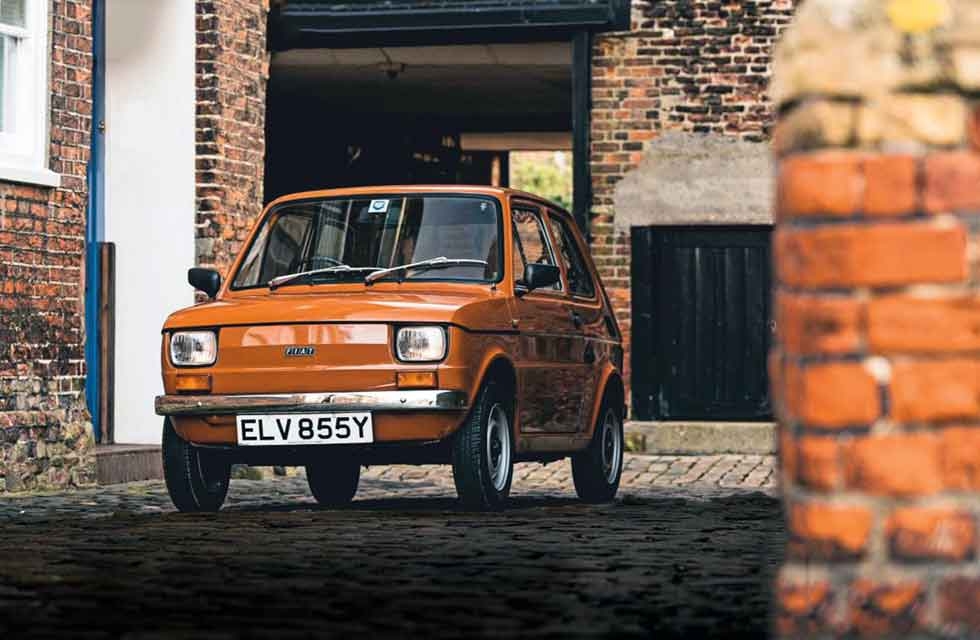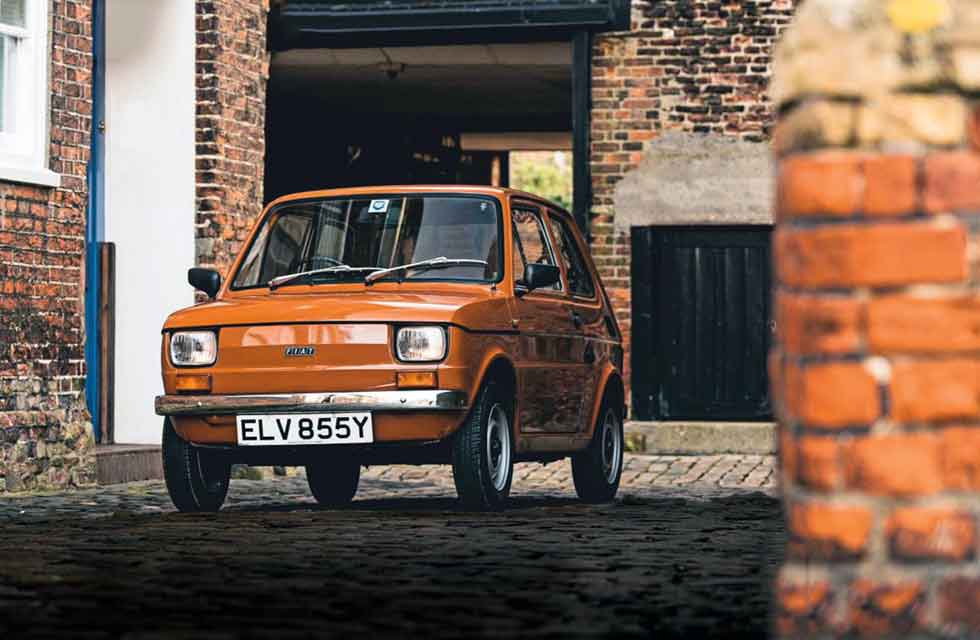
The Fiat 126 might not be an icon to us Brits like the Mini is, but for the Polish this little car changed everything. Words Nathan Chadwick. Photography Jordan Butters.
Little wonder Fiat’s little 126 provided affordable transport for the masses. Despite Polski and Fiat making nearly five million there’s a handful remaining.
ENJOYING FIAT 126 Iron-curtain classic that helped topple communism
ENDANGERED SPECIES: FIAT 126
It may be small but it was mighty – how this little car pushed Poland into the 20th century almost alone. Fiat 126: the car that helped to defeat Communism?
ONLY 190 LEFT
When you think of cars of the people, there are the usual staples. Mini. 2CV. Fiat 500. VW Beetle. The kind of cars that will adorn the tote bag of a fashionista who has never even sat in one, let alone driven one. Vehicles that go beyond transportation – they are cultural reference points.

There’s another one to add to the list – you’re looking at it; the Fiat 126. In Poland, this car is so much more than a tin box with four wheels – it represents the birth of aspiration against a backdrop of communist austerity, a mobilising force beyond the confines of regional and national boundaries, and a catalyst for deep political and social change.
‘YOU’LL SWEAR YOU CAN FEEL EACH PISTON STROKE THROUGH THE BASE OF YOUR SEAT’
In all, 4.7 million were built between 1972 and 2000, yet over here you wouldn’t know – just 190 of various flavours are running, according to How many left. A slightly odd-looking Fiat built (mainly) by Poles was always going to struggle against the likes of the Mini, Beetle and 2CV. That’s despite it being the UK’s cheapest car for a stretch of the 1980s.
No longer – these miniscule machines don’t sell for tiny amounts. This one sold at Anglia Car Auctions earlier this year for £3392, though you can spend twice that for truly mint examples. Some might see that as rather a lot of money for a car easily outrun at the lights by one of my greyhounds at a canter.
That’s missing the point completely. This is a cultural icon to rival that of the 2CV, Beetle or Mini, yet is available for a fraction of the price of any of those. And arguably, as we’ll find out, just as much fun as the best of them…
‘THIS LITTLE CAR’S IMPACT WAS FAR FROM CHILD’S PLAY’
Say hello to maluch (the toddler), kazsler (the cougher), kikirez (little rooster), peglica (little iron), bolha (flea) and egérkamion (a mouse’s truck). All cute nicknames from a variety of Eastern European languages, but this little car’s impact was far from child’s play..
Poland had moved further away from strict Soviet doctrine in the 1960s, with increasing consumerism coming into play, and with that came the re-emergence of the Polski Fiat brand. It had existed since the 1930s building cars and trucks under licence from Fiat, but had been seized and shut down by the Germans on the eve of the Second World War. For the 1960s, Polski Fiat was brought back to life, and started building Fiat 125s under licence. It didn’t cause an overnight petrolhead enlightenment – just under 600,000 cars were in circulation in 1971, when the idea to produce the 126p in Poland was first mooted. This caused sizeable political disquiet – was a mobilised population good for the country?
Political manoeuvrings in the late 60s and early 70s swung from reformist protests to hardcore nationalism and back again, but it had become clear that Poland couldn’t exist behind a trade wall. This liberalisation of consumer spending, under the leadership of Edward Gierek, brought a Western influence (and the associated loans from Western banks that would ultimately prove his downfall) – televisions, home furnishings and, yes, cars, were all on the cards. The Polski Fiat 126p in particular, built under licence by Fabryka Samochodów Małolitrażowych, was used to curry favour with the Polish electorate after years of austerity.
Prior to the 126, buying a car was a considerable challenge thanks to low wages, expensive imports, unfavourable currency rates and frosty relations with the West. There was one prior Polish car of the people – the Syrena – but production was severely limited. Oh, and it was grim. Even though the 126 was finally launched in Poland in 1973, buying one was still tricky – you first had to apply to buy one on merit, and then sit on a waiting list for two years. Canny buyers would sell their allotment for twice the car’s worth on receipt of their 126.
Those who kept it crammed in everything – despite being little more than three metres long and less than a metre and a half wide, it became the family hold all throughout Poland, and eventually the Eastern Bloc. Liberalised foreign travel meant 126s could be seen packed to the gills with people and possessions far and wide, with suitcases piled high on the roof. It even found favour far from Poland.
CAR columnist LJK Setright was an avowed fan. ‘Depreciation should be altogether ignored,’ he wrote. ‘You would only have to buy another (there is no effective substitute), which would be no better and no worse; better to keep it, and keep on using it, until it has been used up.’ This from a man who once, displeased to find he couldn’t find a parking space for his 126 outside a London club, simply drove up the building’s steps and parked it in the entrance hall. The staff seemed largely unconcerned, aside from the possibility of an oil leak.
The car itself slickly became part of Polish’s society’s firmament. But what did the emerging-middle class get for their złotys? Pretty much a Fiat 500, actually. Much of the mechanical parts were carried over from the original Cinq, and placed within a more rigid body designed by Sergio Sartorelli to look like a scaled down 127. The interior was much larger and safer too, though you still wouldn’t want to have a crash in one. Still, at least there’s some padding either side of the wheel and dash-mounted radio. Though, er, not much anywhere else.
It really is basic stuff in here – the windscreen washer is a rubber button in the centre of the dash that pumps the screen with water; you have to set the wipers separately. There’s not much in the way of instrumentation either – a five-digit mileometer and a speedometer that optimistically suggests an 80mph top end.
It’s unclear whether our car is a Polski Fiat or from Italy itself. It doesn’t have the 126p or Polski Fiat badging, but it does have orange indicators (bespoke to the Polish cars), and dates from 1983. Out back is an air-cooled 652cc engine with power driven to the rear wheels. So, a bit like a 911? Well, don’t forsake your GT3 dreams just yet, as despite weighing as much as the rear wing on a modern 911 (probably), you do only get 29bhp to play with. The 650 model we’re in does have more torque than the original 594cc model though – a whole 3lb-ft.
It’s not quick on paper – or indeed tarmac – but it feels lively. There’s simply no getting away from the metallic screech of the two-stroke motor, as there’s very little in the way of soundproofing. It lets its intention known early, spluttering into life with the decorum of a toddler-mid-cold – hence its kazsler nickname.
The steering is completely unassisted, which makes slow tight turns a bit of a slog, though the vast diameter of the steering wheel does go someway towards reducing the effort needed. Once your biceps are warmed up you can turn the 126 seemingly within its own footprint, such is the tightness of its turning circle. Things ease up at speed, allowing you to focus on exercising its engine.
It is possible to drive a 126 without chasing revs, but it’s a small Italian car and that’s what they love doing best. The 126 will happily scream its head off through all four gears but you’ll certainly know about it. You won’t be going that fast either, but you’ll be fully engaged, and probably giggling. It’s that kind of car. Just like the 500 before it, the twin in the 126 is in use much closer to a motorbike engine.
It’s full of ‘character’ and by that read vibration. Pull up at a traffic light and you’ll swear you can feel each piston stroke through the base of your seat.
The drum brakes (fore and aft) are a bit all or nothing; stomp too hard and you’ll lock up. But then that’s all part of this car’s unique persona. If you wanted refinement, you should have bought a Golf.
The car was continually improved. In 1984 the charming chrome bumpers were replaced with plastic, with such luxuries as improved drum brakes, a reversing light, fog lights and hazard warning lights appearing throughout the 1980s. The biggest change came with the launch of the 126BIS in 1987, which featured a Polish built 704cc engine. It wasn’t appreciably quicker, but it was water-cooled, allaying the occasional propensity of the original car to cook its head gasket. Still, if you were a fan of the original you could choose between both right past the launch of its direct replacement, the Cinquecento, before it bowed out in the year 2000. It stopped production at the same time as the Mini, with 4.7m built, two-thirds of them in Poland. Ownership was never easy; aside from the noise and haphazard brakes, fighting corrosion was a year round job, its tiny battery could barely keep it alive and breaking down was common. But the Polish grew to love their little car – there wasn’t a great deal of choice, granted, especially during a worsening economic climate in the 1980s.
The 126 became not just a car, or even just a family car. It became a mobile disco, a meeting room for political dissidents, and even had an episode of a popular children’s TV cartoon dedicated to it. It stars on stage and screen, and The Museum of Technology and Transport in Szczecin not only has many variations on the 126 theme, but part of the production line too. The 126 was a key part of the step change in Polish society. It was a symbol of a growing middle class, and a move away from traditional communist ways. It represented freedom to want, and gave an impetus to strive for more, rather than the threat of a trip to a labour camp. Not bad for a two-stroke Fiat.
Styling aping much larger Fiat 127. One of the last pre-facelift cars sold in the UK. Room for a week’s shop. If you’re single… 652cc engine origins date back to the 1950s. 80mph: a hope that’s unlikely to be realised. It reclines – how very decadent. No diamond cut shenanigans here. Bliss. The heater system, largely unfathomable. More space than a Fiat 500. Unlike the 500, you can break the speed limit. Sparse but stylish: still a tight squeeze. Careful! It might slip between the cobbles.
Drive-My Modern Classics view
Even if you’re not Polish, this car has plenty of appeal. It may not be as pretty as a 500, but it is a very cute, characterful machine that garners plenty of favourable attention. It looks as at home in Camden as it does in Krakow.
If you’re a fan of back-to-basics cars, it’s great too. There’s an honest, simple joy to driving it – it might not handle like a Mini, but it’s difficult to drive this car without a grin on your face as you scream to the top of third (okay, you might not be so cheerful dodging SUVs on the M1…).
After all, they say all good things come in small packages.
FIAT 126 650
Engine 652cc, 2-cyl, OHV
Transmission RWD, 4-speed manual
Max Power 23bhp @ 4800rpm
Max Torque 32lb-ft @ 3400rpm
Weight 580kg
PERFORMANCE
0-60mph 48.0sec
Top speed 65mph
Economy 46mpg
I BOUGHT ONE MILES TINWORTH
‘My mum’s Polish, and some of her greatest memories were going on holiday in the 126 across Europe, towing a tiny trailer with the roof piled high. She had to leave hers in Poland when she moved here in the early 2000s, but a few years ago we bought one to restore between us. I love the fact they’re so mechanically simple. It makes for a great city car, though the ULEZ emissions means I’ve had to move it out of London.’






